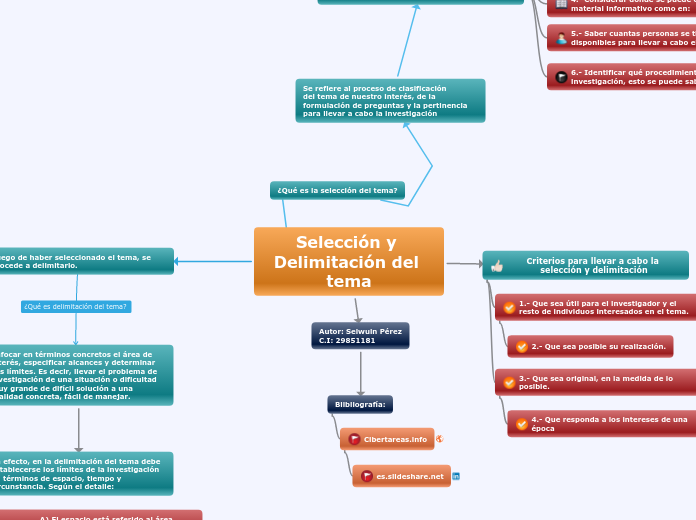¿Qué es el estado del conocimiento?
To name your story, you have to think about the overall message and what you want your audience to understand from the story. Also, make it relevant and easy to remember.
Objetivos y finalidades
The ending of a story is essential. We all know that if the ending is weak, what happened before loses its importance. So make it unpredictable, but fair. A resolved ending answers all the questions and ties up any loose threads from the plot.
FINALIDADES
This is the closure section of the story.
See examples of possible outcomes below:
- all problems have been solved
- it's clear how each one of your characters ends up
- your main character is transformed by the challenge
Obtener información de manera mas especifica, confiable y verídica. Así mismo nos ayuda a que los resultados que se buscan y se obtienen sean desde fuentes recientes y confiable.
Try answering these questions to come up with a closure:
- Have all the problems been solved?
- Is there a clear picture of what happens with each character in the story?
- Has the challenge transformed your main character?
- How do the characters feel in the end?
OBJETIVOS
This is the moment when the main character surpasses the last obstacle and finally faces their greatest challenge.
The climax usually follows one of these patterns:
- realization
- resolution
- choice
Type in your answer.
Estudio para recuperar sistemáticamente, se destacan algunos objetivos como el de indagar y recopilar información
acerca de lo que se ha estado elaborando alrededor del tema, para así establecer un balance de las
investigaciones de forma temática y cronológica (Sepúlveda Cardona, 2008; Chica Pérez, 2009). Así
también, Acevedo Vergara (2009) señala que el estado del arte permite identificar relaciones y dar
cuenta de un concepto o temática en un rango de tiempo
¿Qué es?
The middle of the story is where you add layers of complications that will lead to the end. Reveal more about the character's journey. Did their personality go through changes? How did they overcome the challenges? And as you build up the story’s central conflict, make it more personal to that character. Also, from the middle act, you have to lead into the final act.
como se utiliza?
Your character(s) need(s) motivation in order to solve the challenge(s).
Preguntas detonadoras
Why does your character need to confront this challenge? What does he/she expect to accomplish by solving it?
See a few examples:
- will marry in 3 days
- can fix the mistakes of the past
Las preguntas que orientan
este objetivo son de tipo: “¿en dónde estamos?” y “¿cuál es el camino ya recorrido?”, con el fin de
reconocer lo ya elaborado, para debatir y esclarecer el panorama de la investigación y agilizar el propio camino
Se ha concebido al estado del arte como aquella
metodología que pretende recuperar reflexivamente la producción, permitiendo cuestionar, criticar
y construir, dando sentido a la información obtenida, la cual posee diversas finalidades y niveles,
pasando por el rastreo, registro, sistematización e interpretación
Each story has a main character and that character usually needs to solve a problem or challenge. The character's challenge is the one that creates tension throughout the story.
Como surge
In the beginning of the story (or the exposition), you will need to introduce the setting and characters. You might also want to introduce the main conflict. This part of the story is important because it gives the reader necessary background information and maybe even a first insight into a character’s personality.
¿Para qué sirve?
The setting (time & place) of a story can change throughout the plot.
sistematizar y describir el conocimiento producido analizándolo de manera crítica. En otras palabras, para el autor, luego de organizar la información, es fundamental describir lo encontrado, mostrando a través de una construcción
de sentido los datos recolectados
Sensory details include sight, sound, touch, smell, and taste. These details are important because they create depth in your setting.
See a few examples below:
- the smell of fresh bread
- the scent of freshly cut grass
- rain falling onto the windshield etc.
El final de la década de los 70 y más aún, los años 80 conformaron una época donde las propuestas cualitativas de investigación experimentaban un aumento en su representatividad académica
por lo que se hizo ineludible la aplicación de una estrategia que pudiera hacer visible lo sabido, conocido o trabajado sobre determinada temática o campo de conocimiento
Characters are essential to a good story. Usually, the protagonist(s) is/are the most affected by the plot. Introduce a character by focusing on their actions, interests, and occupation, as the physical appearance doesn't make a difference in most cases.










